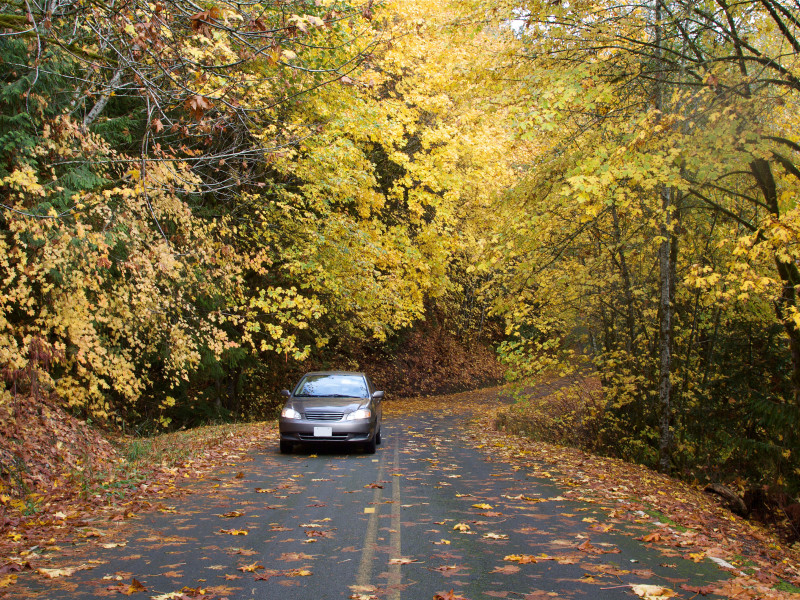Driving in Autumn? Don’t Fall for Slippery Roads With These Tips

As the calendar flips to the vibrant hues of autumn, we're greeted with a spectacle of falling leaves painting our roads with a dazzling array of reds, oranges, and yellows. But beneath this stunning fall tapestry lurks a hidden danger—those same beautiful leaves can create treacherous, slippery conditions for drivers.
In this guide, we'll navigate through the challenges of autumn driving, arming you with crucial tips to ensure the safety of you and your loved ones on the road during this picturesque yet potentially hazardous season.
Getting Your Ride Ready for Slippery Roads
As the calendar pages flip towards autumn, drivers should be mindful of the unique challenges of fall driving. Before navigating through leaf-peppered lanes, one of the paramount tasks is ensuring that your vehicle is prepped for the season. Here's how you can arm your car against the fall follies and ensure a safer drive:
1. Checking and Replacing Tires for Better Grip
Tire Inspection. Regular inspection of your tires for adequate tread depth and no visible damage is crucial. A good tread will ensure better grip on slippery roads.
Tire Pressure Check. As temperatures drop, so can your tire pressure. Maintaining the recommended tire pressure ensures optimal grip and handling.
Seasonal Tires. If you reside where fall tends to be particularly wet or icy, investing in all-season or winter tires could be beneficial.
2. Ensuring Proper Functionality of All Lights and Signals
Checking Lights. Ensure that your headlights, brake lights, turn signals, and hazard lights are all in tip-top condition.
Cleaning Lights. Clean off any dirt, leaves, or debris that might obscure your lights, ensuring optimal visibility and communication with other drivers on the road.
Alignment and Adjustment. Ensure that your headlights are properly aligned and adjusted to provide the best possible illumination of the road ahead without blinding other drivers. It's advisable to have a professional check and adjust the alignment if necessary.
3. Keeping Windows Clear and Windshield Wipers in Good Condition
Replacement of Wipers. If your wiper blades leave streaks or miss spots, it's time for a replacement. Good wipers are essential for clear vision in rainy or misty conditions.
Windshield Maintenance. A clean windshield, both inside and out, helps to reduce glare and ensures better visibility.
Window Washer Fluid. Keep the windshield washer reservoir filled with a washing solution with an antifreeze agent to ensure it works even in cooler temperatures.
4. Regular Maintenance: Brakes, Steering, etc.
Brake Inspection. Have a professional examine your brakes to ensure they are responsive and in optimal working condition.
Steering and Suspension. A proper steering and suspension system will ensure that your car handles well on the road, providing a safer and smoother ride.
Fluid Levels. Check and refill essential fluids like engine oil, brake fluid, windshield washer fluid, and antifreeze to ensure your vehicle runs smoothly.
Essential Safe Driving Tips for Fall
As the air turns crisp and trees begin shedding their leaves, it's a sign that autumn has arrived. While this season is picturesque, it presents unique challenges for drivers. Below are some essential driving tips for the fall season:
1. Keep a safe distance.
As the falling leaves create a beautiful landscape, they can also make the roads slippery, especially when wet. Maintaining a safe distance from the vehicle ahead is vital, allowing ample space and time to react in case sudden braking is required.
2. Reduce speed.
Fall weather can be unpredictable, with temperatures varying quickly. This can lead to icy roads, especially overnight. It's advisable to drive at a reduced speed and brake gently to maintain control of your vehicle under these conditions.
3. Be aware of poor visibility.
Autumn not only brings colorful leaves but also shorter days, rain, and fog. These factors can significantly reduce visibility while driving. Always use appropriate headlights and take extra caution, particularly at dawn and dusk.
4. Watch out for wildlife.
Autumn is when many animals, especially deer, are more active. Be vigilant, especially in areas known for wildlife crossing.
5. Schedule regular car maintenance.
Ensuring your car is in good working order is especially important during fall. This includes checking tire tread depth for better traction and ensuring your brakes function properly.
6. Avoid driving on leaf piles.
While it may seem harmless, driving or parking on dry piles of leaves can be dangerous as they can obscure road markings and hide potholes. Moreover, a hot car exhaust can ignite dry leaves.
7. Prepare for weather changes.
Review the weather forecast before heading out, and plan your journey accordingly. This can help you avoid being surprised by sudden weather changes common in the fall.
8. Be mindful of time changes.
The transition to shorter days can impact drivers, especially commuters. Adapt your driving habits and exercise increased caution during the dimmer morning and evening hours.
How to Handle Your Vehicle if You Start to Skid
Experiencing a skid can be a heart-stopping moment for any driver. Knowing how to handle your vehicle properly is essential in this precarious situation. Here are some steps to regain control when your car begins to skid:
1. Stay calm.
Panicking will only make the situation worse. Keep your cool and focus on the road ahead.
2. Don’t slam on the brakes.
One of drivers' most common mistakes when they start to skid is slamming on the brakes. This can cause your vehicle to lose even more traction and control. Instead, ease off the accelerator.
3. Steer in the direction of the skid.
As counterintuitive as it may seem, steer your vehicle in the same direction that the rear of the car is sliding. This can help realign the back of your vehicle with the front.
4. Avoid oversteering.
Overcorrecting can cause the car to skid in the opposite direction. Make gentle, slow movements with the steering wheel.
5. Use your car’s technology.
Do not pump the brakes if your vehicle has an anti-lock braking system (ABS). Instead, apply firm, steady pressure on the brake pedal and allow the ABS to prevent the wheels from locking up. ABS will rapidly pulse the brakes twice per second to maximize braking power while maintaining steering control.
Likewise, if your car has electronic stability control, do not override the system—it is designed to automatically apply individual wheel brakes and reduce engine power to help you maintain control if a skid occurs.
6. Practice safe driving habits.
The best way to handle a skid is to prevent one in the first place. Always drive according to weather conditions, maintain a safe distance from other vehicles, and ensure your tires are in good condition.
Other Fall Driving Hazards to Be Aware Of
While enchanting, the autumn season brings a unique set of driving challenges. Here are some other fall driving hazards you should be aware of:
1. Sun Glare
The sun's position changes as we move into fall, and it can often result in significant glare during morning and evening commutes. Always have a good pair of sunglasses on hand, and use your car's sun visors to help reduce the glare.
2. Reduced Daylight
With the shorter days, there's less daylight, especially during morning and evening commutes. Ensure that your vehicle's lights are in good working order so you can see and be seen.
3. Tire Pressure Changes
Cooler temperatures can cause the air in your tires to contract, leading to underinflation. Regularly check your tire pressure to ensure optimal performance and safety.
4. School Zones
With the school year starting in the fall, more children will be on the sidewalks and crossing roads. Be especially cautious in school zones and residential areas.
5. Rain and Early Frost
Fall weather can be unpredictable. Sudden rain showers can make roads slick, and early frost can create icy patches on the road, especially on bridges, overpasses, and shaded areas.
6. Fog
Chilly autumn mornings can trigger fog, reducing visibility drastically. If you encounter fog, slow down, use your low-beam headlights, and maintain a safe distance from the vehicle in front of you.
Leaf the Hazard Behind
As autumn blankets our roads with vibrant leaves, navigating with caution and care is imperative. By embracing the mentioned driving tips, you can fully enjoy the season's beauty while ensuring safety. Remember, a prepared driver is a safe driver. Stay vigilant, and let's make this fall folly-free. Safe travels!







